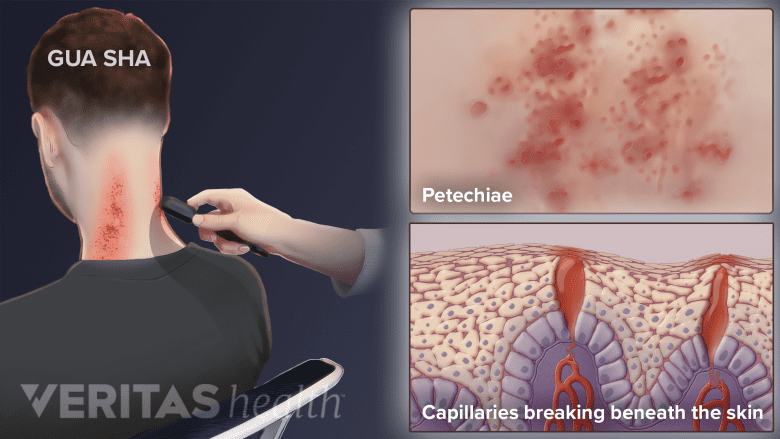Gua sha is an ancient treatment from Traditional Chinese Medicine (TCM). It is performed on areas of the body where it is believed that blood circulation has become stagnant and energy (“qi”) is blocked. By applying the gentle scraping of gua sha to the skin covering the troubled area, the goals are to improve blood circulation and promote healing.

In gua sha, the skin is gently scraped to enhance blood circulation and promote healing.
Treating neck pain is one of the more common applications of gua sha.
In This Article:
- Gua Sha for Chronic Neck Pain
- Efficacy and Risks of Gua Sha for Neck Pain
How Gua Sha Is Applied
Gua sha typically involves applying a massage oil or other lubricant to the skin where the treatment will be performed. Then a spoon or other rounded object with a blunt (not sharp) edge is used to apply short strokes down the skin. Sometimes these gua sha motions are referred to as “scraping” or “press strokes.” The length of these strokes can vary depending on the treatment and practitioner. Press strokes that are made over bony areas, such as the cervical spine in the neck, are done more gently than over flatter or muscular areas.
A gua sha application may take several minutes or longer. After the gua sha treatment is completed, it is advised to take it easy for the rest of the day, including no alcohol.1Gua sha FAQs. Arya Nielsen, PhD, Gua Sha Web site. guasha.com/faqs/ Updated 2013. Accessed February 6, 2018. This recommendation to relax is based on the belief that the gua sha treatment has gotten the blood and energy flowing again, and too much activity too soon may reduce its benefits.
Sometimes gua sha is combined with other treatment methods, such as acupuncture.
How Gua Sha Looks and Feels
Gua sha may look strange or appear painful to observers who are unfamiliar with this treatment. When a practitioner press-strokes the skin with a rounded edge during gua sha, the tiny blood vessels (capillaries) beneath the skin can break. This process makes the skin develop red spots (petechiae) and looks like a rash or bruise. The size and darkness of the resulting spots can vary greatly, depending on the patient’s condition as well as the practitioner’s skill. The redness usually goes away within 2 to 4 days.1Gua sha FAQs. Arya Nielsen, PhD, Gua Sha Web site. guasha.com/faqs/ Updated 2013. Accessed February 6, 2018.
Gua sha is not typically described as painful, but in some cases the application can be uncomfortable. The practitioner must feel (palpate) the neck for muscle tightness and other abnormalities, and the press-strokes applied during gua sha involve a significant amount of pressure (but not as much force as deep tissue massage).
See Neuromuscular Massage Therapy
In some cases, pain relief may begin immediately after the treatment is done. Although, not everyone experiences pain relief from gua sha.
Who Applies Gua Sha
Gua sha is typically applied by people who are licensed in acupuncture and/or Chinese medicine theory. It is important for the practitioner to be specifically trained in gua sha to reduce the risks, such as pressing too hard, irritating weakened skin that cannot tolerate gua sha, or spreading an infection via unsterilized equipment.
- 1 Gua sha FAQs. Arya Nielsen, PhD, Gua Sha Web site. guasha.com/faqs/ Updated 2013. Accessed February 6, 2018.

